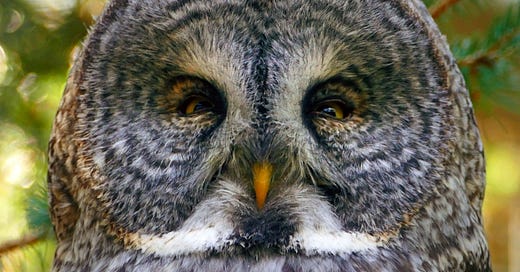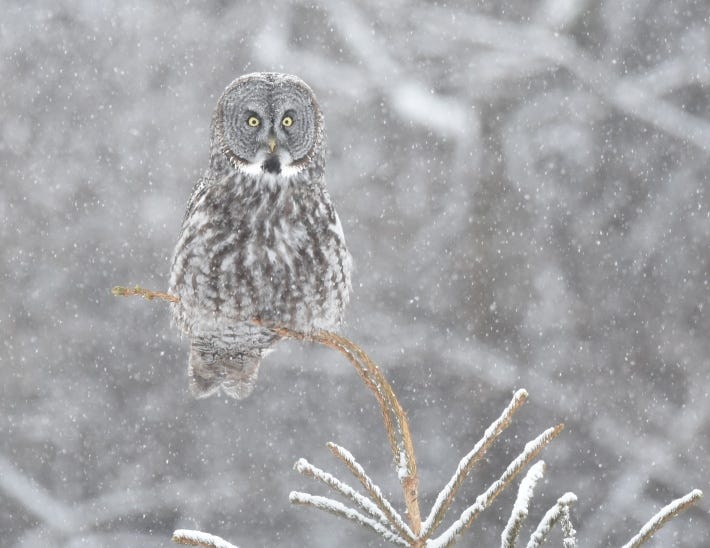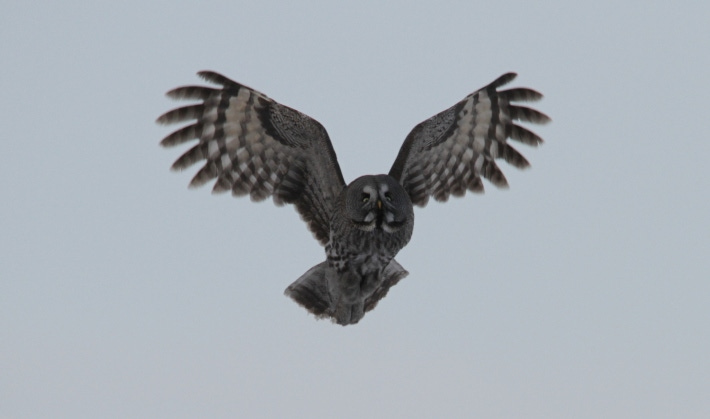Sometimes I have to do a little explainer about the meaning behind the name of the Bird of the Week. Not this week, though! This week's bird is the Great Gray Owl, and really, when has a name told you as much about what you need to know? The bird is an owl, it is gray*, and boy is it great.
I mean...BOOM. Talk about an entrance. The National Park Service notes drily that the Great Gray "sports a large facial disk and yellow eyes," which is an understatement on the level of saying that Miranda "makes interesting life choices" on And Just Like That. This bird's face is a work of biological art!
Owls are just something else, y'know? They have such a mysterious grace about them, those faces that suggest they have depths of knowledge we will never be able to match, that bearing that hints at a kind of sublime connection to the very core of the planet...I'm not stoned I promise, the Great Gray is just bringing this out of me! And not just me. Everyone who ponders this creature is led into flights of fancy. The NPS says that the Great Gray "becomes one with the forest," which is not the usual language of a federal bureaucracy. Common nicknames include "Phantom of the North" and "Great Gray Ghost." It's practically a mystical creature!
OK, enough rhapsodizing, let's get down to some facts. The Great Gray Owl can be found across a vast portion of the colder northerly regions of the globe, from the northern U.S. into Canada and Alaska and all the way through Scandinavia and Russia. It feeds on small rodents like the pocket gopher and especially the vole, eating up to seven per day. (SO much vole!) It is so tied to these creatures that its migratory patterns fluctuate depending on the supply of little critters it has to eat.
It also has super-duper hearing which helps it root out prey even when the animals are nearly two feet beneath the snow. Here's a video from National Geographic which shows how it does this (ignore the very dumb production choices which make the owl seem like a Dateline criminal rather than a majestic creature fulfilling its evolutionary functions):
Let's do another picture.
If I saw that IRL I would faint.
One of my favorite facts about the Great Gray is that it is something of an optical illusion. It is one of the largest owls in the world (or possibly even the largest!) and, at the same time, it's not that big at all. Here's the Peregrine Fund to explain:
You have heard the expression “wolf in sheep’s clothing”? With the Great Gray Owl, it is more a case of “little owl in big owl clothing.” Though this owl is the largest owl in North America – measuring about 2 feet tall – it weighs only 2-4 pounds. Compare that with a Eurasian Eagle Owl, which is just slightly larger, but weighs 3-9 pounds and you will see what we mean. Why is this so? Great Gray Owls have relatively small bodies but are covered in so many dense layers of long feathers that they appear to be much bulkier than they are. It would be like you wearing all your clothes at once, which would definitely make you look much bigger. One advantage to this could be protective – a large appearance can be deceiving to predators and make them think twice before attacking such large prey.
You beautiful trickster!
Let's round things out with a couple more videos. Here is a Great Gray Owl family being all bonded and stuff. This video is so adorable if you can get over the fact that all the love is centered around sharing a small rodent carcass:
Here is the call of the Great Gray—higher-pitched than I would have imagined!
And here is some excellent flying footage.
Fly on!!!
*The owl is also known by some as the Great Grey Owl, with an "e" in "grey," but I am using the American spelling, because, despite being a rather hardcore Anglophile, I am not English! Americans using "grey" instead of "gray" in things that otherwise contain all-American spelling is actually one of my editorial pet peeves. If I'm editing a story of yours and you use "grey" in this way, I WILL change it, just letting you know!
A reminder: you can check out our complete Bird of the Week list here, and get in touch with your bird suggestions at hello@discourseblog.com.







